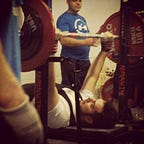What Explains the Barbaric Enjoyment of Watching others in Mortal Danger?
A few years ago I was scrolling through Quora and found a variation of this question. The original referred to people of the past and immediately I thought about MMA and gladiators. This is a timeless question and one that those who have dove deep into the topic can answer with case studies upon case study but also one where readers of all walks of life can pause and think.
What is it about fighting that is so interesting to watch?
Around the time that I read this question, I was also reading a book on the gladiators and how the violence of the arena was hard to resist even for some of the saints of the christianized-Roman Empire
I found this example of a Bishop in the Fourth Century and how his one off, reluctant experience at a gladiator match shook him, to be relevant.
The Christian Saint, Augustine (354–480 C.E.) had a friend named Alypius who was a bishop. Alypius was dragged to a gladiatorial match by his other friends and Augustine gives us an account of Alypius’ fascination:
“For soon as he saw the blood, he at the very instant drunk down a kind of savageness; nor did he turn away his head, but fixed his eye upon it, drinking up unawares the very Furies themselves….Nor was he now the man he was when he first came thither, but become one of the throng he came unto; yea, an entire companion of theirs that brought him thither.” — -Augustine writes in Confessions
A Mirocosm of Roman society
Gladiators were a fearsome spectacle. Surrounded by cheering crowds of violence-hungry Romans. All came together to watch sports entertainment at the local arena.
In the arena there were a variety of characters: murmillones (fish fighters) , hoplomachi (armed fighters), venatores (hunters), provocatores (provokers), and equites (horsemen).
Even exotic animals got into the mix.
The animals used in deadly arena combat along with the variety of people and ethnicity,were symbols of the extent of Rome’s dominance in territory.
Originally these arena battles were used to commemorate death, called munera. Yet, gradually, they began to be utilized for political gain and favor amidst the greater population.
Why? Well, they helped in keeping the peace.
Arena sports helped maintain the civility of Roman citizens in their day-to-day lives, says Christopher Epplett in his book, Gladiators: Deadly Arena Sports of Ancient Rome.
The violence depicted in arena sports, Epplett says, were used as a release for the inner violence of Roman citizens. By allowing a level of violence ABOVE that which was tolerated in every-day society, the Roman arena allowed the quenching of thirst of people’s inner beast.
On that note, think of the modern day popularity of mixed martial arts. To those not “into-it” it seems very violent. Incredibly so.
Yet it might be as a result of the quenching people’s blood thirst in the modern world of sedentary overload.
ALL THE PREVIOUS FIGHTING HAS BEEN MERCIFUL BY COMPARISON.
Now finesse is set aside, and we have pure unadulterated murder.
The combatants have no protective covering; their entire bodies are exposed to the blows. No blow falls in vain.
This is what lots of people prefer to the regular contests, and even those which are put on by popular request.
And its obvious why.
There is no helmet, no shield to repel the blade.
Why have armour?
Why bother with skill?
All that just delays death.
In the morning, men are thrown to lions and bears. At mid-day they are thrown to the spectators themselves.
No sooner has a man killed, then they shout for him to kill another, or to be killed.
The final victor is kept for some other slaughter.
In the end, every fighter dies.
And all this goes on while the arena is half empty.
— SENECA, Roman senators and philosopher, on death in the arena. Used as back sleeve of Christopher Epplett’s Gladiators: Deadly Arena Sports of Ancient Rome
You can see how the sport called to the restlessness in the average person. And it was for this reason that gladiatorial arenas were built all around the Roman Empire. By exposing people to a level of violence above what was tolerated in everyday society, the average person was able to find release and was less likely to engage in violent behaviour outside.
Maybe more people in the modern age of high anxiety could benefit from more contact sports, where blowing off steam can come with a mutual agreement of no hard feelings.
If you enjoyed this article you can find more on my newsletter, the Chronicles of Fitness Newsletter, where you’ll learn insights into history while learning tips and strategies on getting better physically fit to perform and fight the anxiety of the modern world.
